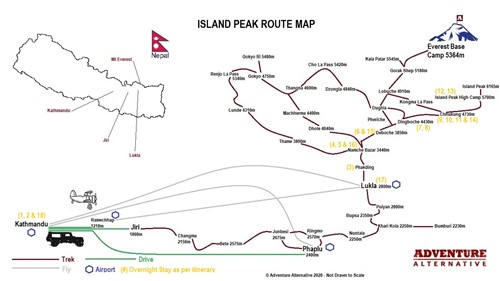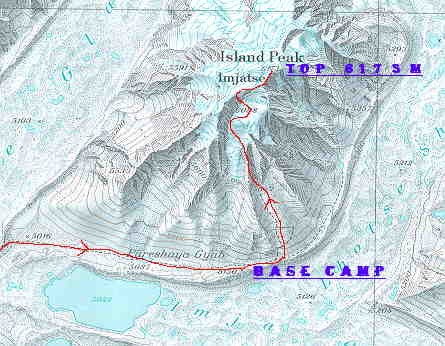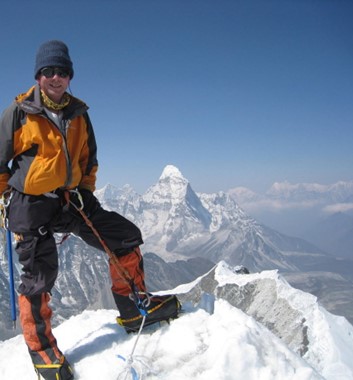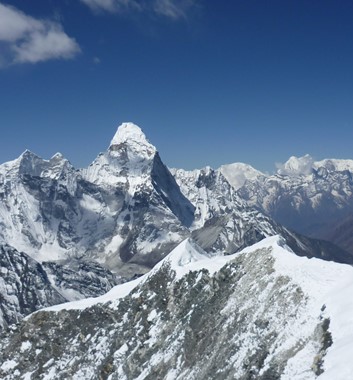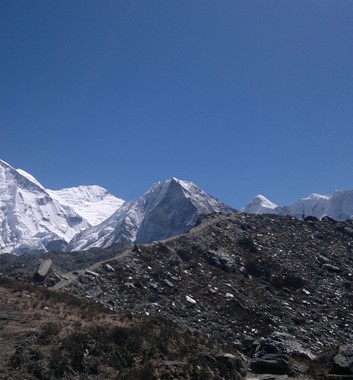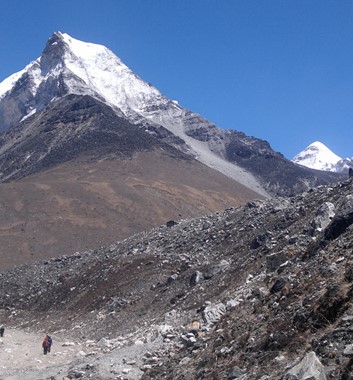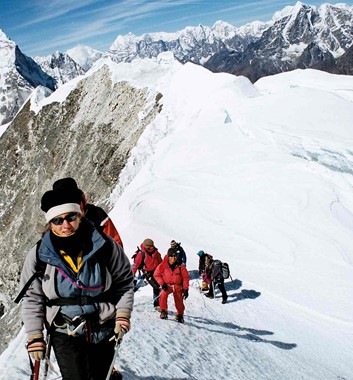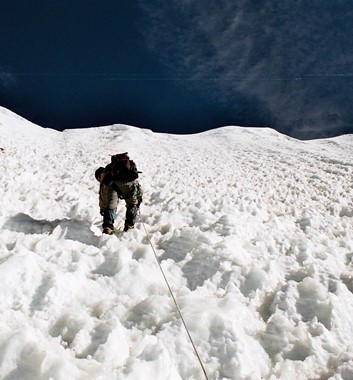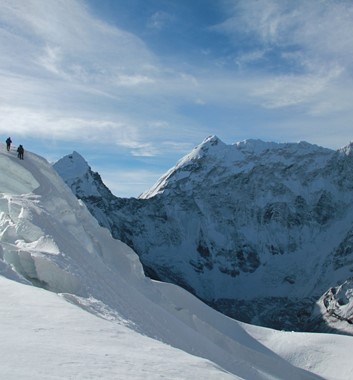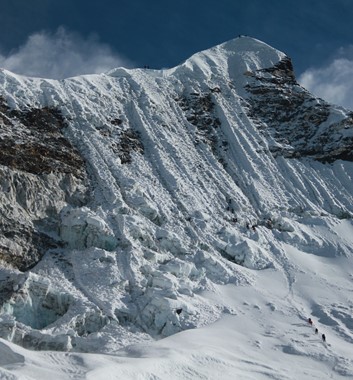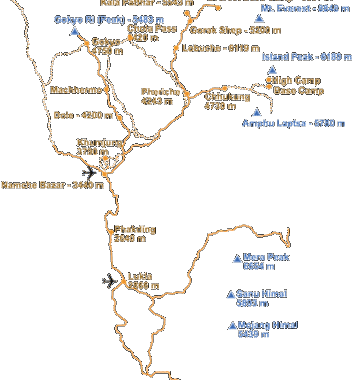Overview
Locally known as Imja Tse, Island Peak is a spectacular peak amid the giants of the Himalaya. Tucked away up the Chukkung valley this beautiful mountain does indeed look like an island which is dwarfed on both sides by the stupendous Lhotse/Nuptse South Wall to the north and Baruntse to the south. The views from the top of this mountain are truly wonderful, and all the more memorable for a spectacular airy ridge climb to the top.
If you have dreamed of climbing a technical 6000 metre Himalayan summit then this famous mountain may answer your wishes. It was actually a training peak used by Edmund Hillary and Sherpa Tenzing in 1953 and the route they discovered is the same one that is used today. In fact Island Peak is still a popular training peak for clients attempting Mount Everest because a lot of the skills required - crossing crevasses with ladders, using jumars on a fixed line - are the same.
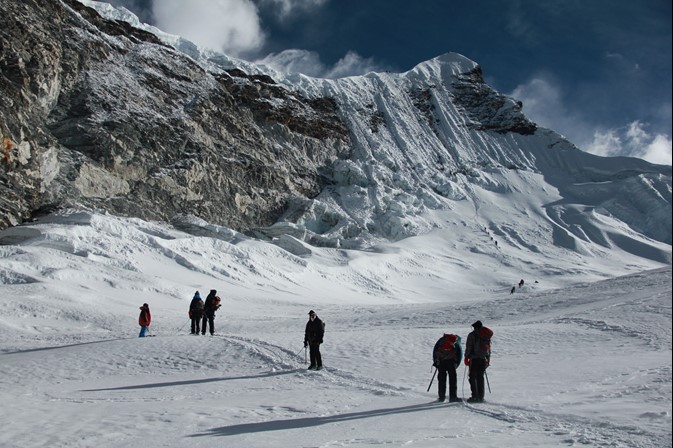
Crossing the glacier on the way to the headwall which is 300 metres in height.
SUMMARY OF THE ISLAND PEAK ITINERARY
The Island Peak expedition is a minimum 19 days when you include days in Kathmandu and has 16 days on trek / climb. We do recommend allowing extra time for potential flight delays getting into and out of the mountains.
The gradual ascent up the Khumbu valley allows for excellent acclimatisation, which is further enhanced with a climb up Chukhung Ri (5550m) for a great view of the south wall of Lhotse. There is also the optional extra (see cost tab) of adding on an adventure up the Kongma La pass with it's classic views over the Khumbu Glacier and a climb of Pokalde (5806m).
Our main objective, Island Peak, is the final highlight of the trip and a classic 6000m peak which was climbed by Edmund Hillary and Sherpa Tenzing back in 1953 as their training peak for Everest. By the time we come to climb you'll be well acclimatised and mountain fit.
During the trip, you will learn and use many skills in safe travel on mountains at high altitude including glacier travel, scrambling and moving on mixed snow and ice terrain. Good alpine skills are a requirement for this trip and if not possible to learn these before you join us them you will have plenty of time to learn and practice them before reaching Island Peak. The summit day on Island Peak does involve crossing a crevassed glacier using a climbing rope, negotiating some ladders across crevasses, using a jumar to ascend a fixed line and then a descender to come back down again (there is no top rope on the abseil) and negotiating a narrow exposed ridge to the summit.
| Days | Summary |
| 1 | Arrive in Kathmandu (start date) |
| 2 | Rest day in Kathmandu, permits, rentals etc |
| 3 - 8 | Fly to mountain airstrip at Lukla and trek up to Dingboche 4252m, rest day |
| 9 - 11 | Trek to Chukkung 4730m. Optional climb of Chukkung Ri or Pokalde peak with camping (see Cost tab). Back to Chukkung. |
| 12 | Island Peak base camp at 5100m, preparations. |
| 13-14 | Summit days |
| 15-17 | Trek back to Chukkung and back to Lukla |
| 18 | Fly into Kathmandu (allow leeway for delayed mountain flights, at least 24 hours). Depart for home on minimum day 19. |
Note: some people like to also complete the trek to Everest Base Camp prior to climbing Island Peak. If you would like to do this then add two days to the trip and contact us to arrange. Remember to always allow leeway for the return flight home because the mountain flights in and out of Lukla are often delayed by bad weather. We recommend a minimum of 24 hours but 48 hours is better
CLIMBING ISLAND PEAK
The expedition not only provides an enjoyable climb but also provides some of the most spectacular scenery of the Himalayas in the Khumbu region. From the village of Dingboche Island Peak is clearly seen at the top of the valley as a pyramid of ice and rock. It was named by Eric Shipton because of its resemblance to an island in a sea of ice. The mountain itself is the extension of the South Ridge of Lhotse Shar separated by a col and the ridge rising to the south from this point leads to the summit of Island Peak.
The approach route follows the Chukkung Valley to Base Camp, from which the summit is a challenging 9 to 12 hour round trip depending on conditions. The route includes circuitous rocky paths and scrambles to the snow line, followed by a section moving in rope teams across glaciated and crevassed terrain and then a 300 metre headwall to the summit ridge. The headwall is fixed with a rope to clip onto, and this extends all the way along an exposed summit ridge about 300 metres long which is narrow and precipitous but not steep (see photo below). The top itself is quite small with only enough room for maybe four or five people to stand safely.
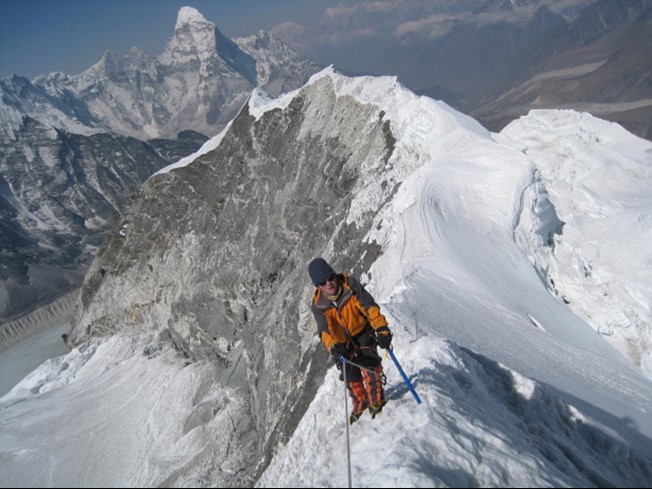
On the final summit ridge with Ama Dablam in the background.
After climbing the 300 metre headwall and ascending the exposed summit ridge, the view from the top brings the thrill of Himalayan mountaineering because of the spectacular 360-degree panorama of many of the highest mountains in the world. Seen from the summit, the giant peaks of Nuptse (7,879m), Lhotse (8,501m), Lhotse Middle Peak (8,410m) and Lhotse Shar (8,383m) make a semi-circle to the north. The views of Makalu (8475m) in the east, Baruntse and Ama Dablam in the south add to the 360 panorama.
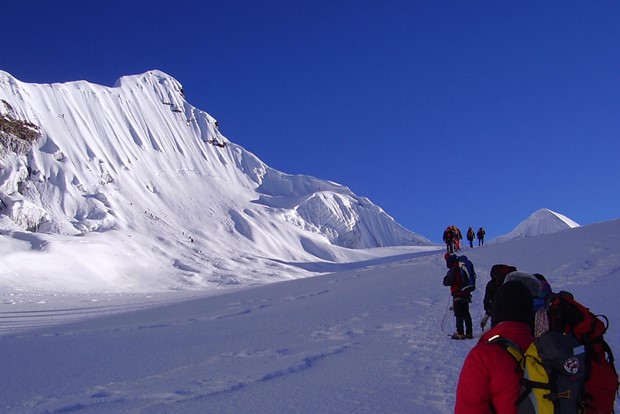
The fixed line extends up the headwall about 300m and along the narrow summit ridge to the top. The conditions can be hard and icy or quite deep snow, it depends on the time of year and local weather conditions.
ISLAND PEAK TREK ROUTE MAP
Click on the maps above and below for a large version
ISLAND PEAK SUMMIT ROUTE MAP
From the village of Chukkung, it is a four hour hike to Island Peak Base Camp on easy ground. The route goes past the famous Imja Tse lake which has recently been drained a bit because of fears that warming due to climate change would cause the lake to break its banks and flood the whole valley.
Terrain on the Island Peak trip
The walk in initially follows the main Everest Base Camp trek and is on a well-trodden path all the way though this can be rocky and uneven in parts.
Once on the mountain itself there will be scrambling on quite loose rock to 'crampon point' at the snow line. This is done in the dark from a 4am start on the ascent and often requires the use of hands to assist. There are some steep drops and the path follows a circuitous route through the scree and bottom rock formations.
From crampon point the route is on snow and there are numerous crevasses to cross and you will be roped up in groups of three or four on glaciated ground. Some of the crevasses are deep and there will be ladders to negotiate, which are not difficult but do require care and alertness. The route is normally well marked, and groups only follow one designated 'path' on the glacier because there is a danger of falling into slots or hidden crevasses if you stray too far.
At the base of the headwall you will move onto the fixed lines which need to be checked for their robustness. The anchors are normally strong and every thirty metres or so, but especially in the afternoon they can become loose. The lines themselves are normally polyprop (not kernmantel) and can get icy and slip through jumars. The gradient is around 40 degrees at it's steepest but averages less than that. There are plenty of places to rest for a bit, and the whole headwall of 300 metres normally takes about an hour and a half. Quite often you can find yourself behind other parties, which slows things down.
There are normally 'up and down' lines on the headwall, but people get confused and so it is important to check which line you are using and if it is clear, and to make sure there are not other people pulling on one anchor. Climb without hauling on the jumar, it is a safety aid and hauling back on the rope is generally bad practise. The route nowadays is normally hard ice so your crampons points need to be sharp, but you can also get soft snow with big buckets to negotiate. Pre-monsoon is more likely to be harder ice, post monsoon more likely to be soft snow, but much depends on the local weather at the time.
Once on the summit ridge, the route is narrow and exposed and often busy with people. There is normally only one fixed line going to the top and only space for a small group of about five on the summit. You will need to negotiate with others on the route. There are a few steps which are more exposed and steeper than others, but the route is not difficult in good weather with little or no wind. Be careful with always clipping the safety karabiner across an anchor first before moving the jumar over. This is a very important safety manoeuvre to avoid ever being unclipped from the rope.
The descent is tiring but extra caution should be given to the initial section of abseil from the summit ridge. For those with experience, it is an easy abseil and plenty of 'shelfs' to move to. Be careful that someone is not clipping onto the down line on the way up! Some people are very unsure about abseiling and can slow things down a lot. Sometimes it is possible to overtake at a suitable platform, but often there is tension as people get frustrated with slow progress, especially if it is getting late in the afternoon.
Once back on the glacier be very careful coming back in sunlight; the snow will not be as hard packed and the ladders may have loosened. Keep the man ropes taut and follow good climbing principles all the way. Keep to the route.
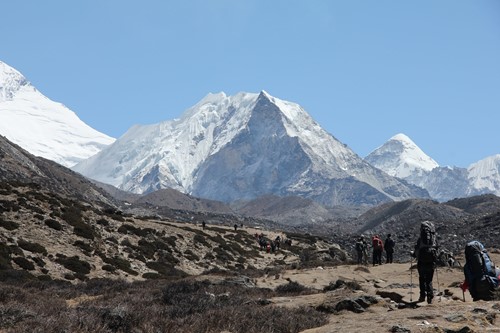
This is the approach trek from Dingboche to Chukkung with Island Peak the centre of our attention. We then go around her southern flank, which is to the right of the peak in this photo.
ISLAND PEAK ALTITUDE PROFILE
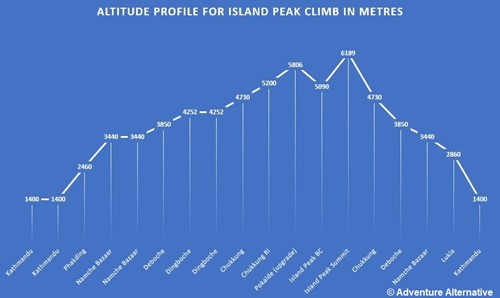
Click the image above for a larger version
ISLAND PEAK ACCOMMODATION
Accommodation on the trek will be in comfortable lodges run by local families, unless people specify a preference for tents. Each lodge has a central communal area with stove, while the bedrooms are unheated with two beds and mattresses, blanket and pillows. You will need to bring a sleeping bag. The lodges generally have showers which are powered by gas and some use the infamous ‘drop’ toilets, though most now have flush systems now.
Food on the trek is very good quality, and a mixture of local Nepali / Sherpa food and western recipes. Burgers and chips are a common meal, as is dal bhat with rice. You will find everything from fresh pastries to beer, stir fries to deep fried Mars bars available in the lodges and shops a Nepal price guide can be found here. And there are many shops selling all types of drinks and snacks, sweets and chocolate. The biggest challenge will be avoiding all the unhealthy foods and sticking to a simple diet of rice and dal!
At Island Peak base camp we will be camping. We will be in mountain tents usually sleeping two persons per tent. Bring a 4 season sleeping bag and also a good quality sleeping mat. For lower down you may wish to use a sleeping bag liner to sleep in a open zipped 4 season bag, so that you don't get too hot.
The porters will carry your main bag up to a maximum weight of 15 kgs and cater for all the group needs, you will also have your guide and climbing guide with you throughout to ensure you are safe and happy.
CLIMBING EXPERIENCE NEEDED FOR ISLAND PEAK
Previous winter mountaineering experience is important and necessary for this expedition. Knowing how to put on crampons and walk safely with them, using a walking or ice axe correctly and tying into a harness and onto a man rope are important skills to have. Walking safely on a man rope on glaciated ground is all part of the experience, but previous experience is absolutely necessary. Our guides will teach you and guide you, so make it known to the guide the level of your experience.
On the headwall, it will be necessary to use a jumar and safety karabiner attached to your harness to ascend (sometimes known as a 'cows tail'), and a descender to abseil back down again. This is not the place to abseil for the first time, so please make sure you have gained some training and practise beforehand. The abseil is on a single line and you will be completely self-reliant, it is not possible to top rope this section because it would take too long to set up, unless absolutely necessary of course.
The crevasses are quite manageable and not too wide, but crossing ladders can be a disconcerting experience. There are handrails attached to snow stakes in the ground, but some people do find it difficult. The best option is to walk across with the crampons placed across the rungs of the ladder, but some people choose to go on hands and knees.
The headwall on Island Peak is not very steep but it looks more daunting from afar and face on. Once on it, you will find there are plenty of places to rest and stand on ledges. It doesn't seem nearly so steep or difficult. Many people opt to 'jug' up the ropes, pulling back on the rope with their jumars and essentially hanging their weight on the line. Sometimes a single line can have several people hanging off it, and this is dangerous. The anchors may have been put in place several days ago, and the rule is never to trust an anchor until you have either put it in yourself or have seen it with your own eyes. So therefore try to climb the route with your crampons points and axe, rather than hanging on the rope.
The summit ridge is quite 'airy' with steep drops off to the sides. Therefore you will need to be able to concentrate and keep your composure. This is not a place for people who suffer from vertigo or don't like precipitous drops. Experience of ridge walking will help and of course a confident attitude which comes from feeling comfortable on your crampons and using your axe. This is not a place to be using this equipment for the first time. At this stage the guides cannot be alongside you, they will be either behind or in front on you on the rope so most of the work is being done by you alone. Knowing how to move your jumar safely across an anchor safely is vital. It goes without saying that the rule of always keeping clipped in applies here.
In terms of training courses, some of the skills for Island Peak are different to what you find on alpine courses. In general the experience you will gain is invaluable of course, especially ropework and moving confidently and safely on glaciated ground. However, fixed lines are uncommon in the Alps so make sure to mention to your training guide that you would like some work on using jumars safely and abseiling on a fixed line without being top roped.
In summary the trek up to base camp of Island Peak is all relatively easy, staying in lodges and enjoying the walks in the valleys. Once you start up from base camp in the dark on the loose scree and then onto snow, then alpine skills and team skills on man ropes are going to be important.
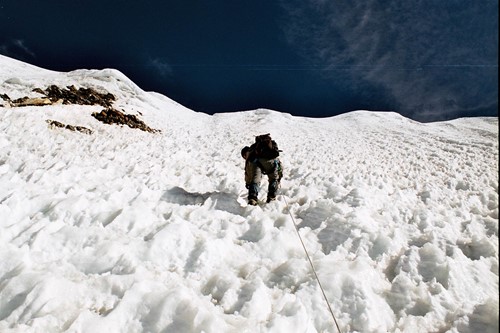
The headwall on Island Peak that leads up to the summit ridge
ISLAND PEAK SUPPORT TEAM
From your first enquiry and in the build up to your trip you'll have direct access to experienced and professional guides and climbers for advice or to ask questions. Then, on arrival in Nepal, you'll meet Tsering, our operations manager in Kathmandu who organises all the staff, equipment, permits and hotel arrangements. He is also the main link between you and the UK office when you are in Nepal.
Tsering will introduce you to your trek and climb guides at the briefing in Kathmandu and will also talk guides regularly on the trek / climb when signal is available. He can also make arrangements while you are on the trek. You also have continued support from the main office in the UK. In the Khumbu region there is an opportunity to communicate since most lodges now have WiFi. We will always try our best to assist with any situation and of course we will provide you with all the advice and support you need prior to this trip. In addition:
- You will travel with our qualified, time proven, guides who not only lead trekking groups but are experienced in high altitude expeditions.
- Porters' health and welfare is constantly monitored by local and UK trekking group leaders.
- All the staff in our UK office have been to Nepal and we are qualified mountain professionals so you can chat to people who understand what it's like to go up for the first time, before you go.
- We provide insurance cover for all of our Sherpa guides and local staff in the event of an accident or need for repatriation.
- Preparation information and support is available to help you plan.
- We advise you to read our advice on altitude health and acclimatising safely.
You can speak directly with Gavin Bate about your proposed climb of Island Peak and have the benefit of somebody who has climbed the mountain many times and who will go through the whole expedition from start to finish. In the office you will find friendly and knowledgeable staff who will give you the time to discuss through all your preferences and questions.
Our company is properly insured and financially protected, so that your money is safe and you know you are dealing with a tour operator that is correctly set up to manage and run trips like this.
ISLAND PEAK EMERGENCY AND EVACUATION
Helicopter evacuations are the common way of dealing with an emergency in Nepal and there is a very established system for dealing with the logistics. It is obviously important to have travel insurance in place and to be clear on your destination and what you are doing to the insurance company. In the event of an emergency the initial job of moving a casualty will be the responsibility of the team itself and the guide and porters and anybody else nearby. The task will be to move the casualty to the nearest safe place and then to a point where an evacuation can be made. On a Himalayan peak this could be some distance and take some time. Bad weather is the most common reason for delaying helicopter assistance so it's important to acknowledge that there is a requirement for self-sufficiency and self-management in the mountains.
Horses are commonly used for assisted descent and they normally charge around USD$150.00 per day which needs to be paid in cash. A helicopter evacuation can be organised through your insurance company but there will need to be some direct communication with the insurance company to open a case and explain the circumstances. This will require you to have your policy number, name and address and the date on which you paid for the insurance policy. We don't normally carry a satellite phone because of the ubiquity of mobile phones now, but it may be necessary to walk some distance to reach a lodge where there is phone connection.
In the case of altitude sickness the best advice is not to take risks and descend. Further ascent can lead rapidly to the much more serious cerebral or pulmonary oedema which is incapacitating, so normally if you are feeling really bad then best to descend while you're still mobile. There is plenty of literature on acclimatising and using the appropriate drugs but even with medication you should still descend.
Incidents are very rare and Island Peak is in a well supported region of Nepal with the Himalayan Rescue Centre located in Pheriche a short distance below Chukkung.
KIT AND EQUIPMENT FOR ISLAND PEAK
- BAGS - Large Rucksack or duffle bag ~80L (for a porter to carry) + medium daypack ~40L (carried by you)
- SHELL - Top and bottoms
- INSULATION - Warm layered system to keep you warm, down jacket for summit day, sun hat and warm hat
- BASE LAYER - one or two thin layers to wick away sweat and to strip down to when it gets hot
- FEET - Crampon compatible boots, trekking shoes and base camp shoes
- HARDWARE - Crampons, walking axe, alpine harness, descender, jumar, 4 screwgate karabiners, helmet, 2 x 120cm slings, poles
- SLEEPING - 4 to 5 season sleeping bag
- EATING/DRINKING - Water bottles & favorite snacks for during the day, insulated cup, flask
- WASH KIT AND MEDICAL KIT - To allow you to wash and manage minor first aid situations
- ADDITIONAL - Sunglasses, suncream, lipsalve, camera, headtorch
RENTAL ITEMS
We have a number of items which you can rent for this trip and we will have them supplied to you in Kathmandu.
- Mountaineering Harness
- Descender, jumar, Karabiners, slings
- Crampons
- Walking Axe
Plastic boots or double mountaineering can be rented from the village in Chukkung.
ADDITIONAL KIT INFO
Boots for the climb need to be of a type that will allow fitting of crampons. They also need to be warm and fitted well to your feet. There is a huge range of boots available, a lot of which will not be suitable for this climb. For Island Peak you will need boots graded at least B1 for crampon use. If you are planning on doing more mountaineering in the future on higher or colder routes it may be worth investing in B2 hybrid or B3 rigid Plastic boots both of which will also be suitable for Island Peak. Full 8000m triple boots are not needed for this climb but could be used if you already have them.
The porters will carry your main bag up to a maximum weight of 15 kgs and cater for all the group needs, including assisting you if you need to go back down the valley. Unless specifically tenting, all accommodation is in lodges or teahouses which are very well equipped, warm and sociable.
We have a more in-depth look at what is required for your climb.
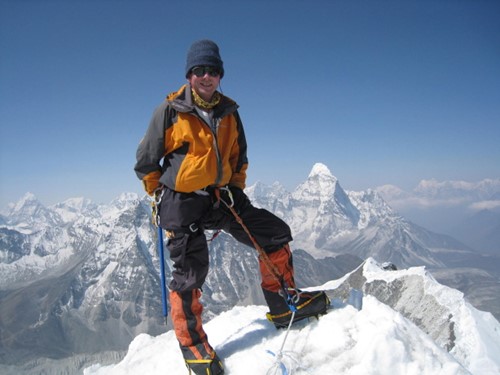
The Summit of Island Peak, with Ama Dablam in the background
Do have a read of our various Blogs about treks in Nepal and also the 'More Information' section, both have tabs on this page and will answer every question you may have! We also have a lot of useful information on our Nepal Preparation page.
Dates & Bookings
Itinerary
Itinerary for climbing Island Peak
| Day | Elevation | Travel Time | Info |
|---|---|---|---|
| 1 | 1400m | Arrive Kathmandu. Stay in either the AA Guesthouse or local hotel. | |
| 2 | 1400m | Rest day and briefing in Kathmandu. Possible drive to Ramechhap** - see 'Lukla Flight' details below. | |
| 3 | 2460m | 4 hrs | Flight* to Lukla, walk downhill to Phakding or Jorsale along the edge of the Dudh Kosi River. Easy, busy path, surrounded by forest. |
| 4 | 3440m | 6 hrs | Uphill to Namche Bazaar which is the Sherpa capital in the heart of the Khumbu region. Nowadays there are also many equipment shops, internet, bank, post office, cafes, bars, lodges and hire shops here. |
| 5 | 3440m | This is an acclimatisation day which you can rest or enjoy the sights and sounds of Namche. | |
| 6 | 3850m | 6 hrs | Walk to Deboche which is near the famous Thyangboche Monastery. |
| 7 | 4252m | 5 hrs | A gradual gradient up to Dingboche. The path continues along the side of the valley with the river far below on your right and passing beneath the spectacular Ama Dablam. The village sits on the confluence of two valleys and has spectacular views. From here you have views of Island Peak up the Chukkung Valley. |
| 8 | 4252m | This is another rest and acclimatisation day. You can visit the Himalayan Rescue Association to listen to the daily lecture on high altitude health, and get a check from the medical staff. | |
| 9 | 4730m | 5 hrs | Trek up to the village of Chukkung and overnight in lodge. Extra equipment hire is here. |
| 10 | 5200m | 4 hrs | Options include a trek up to Chukkung Ri for acclimatisation or camping at the lakes below the summit of Pokalde and a climb of this peak in the early morning. Or a rest day. If the weather is looking good then it may be better to go straight to Island Peak. |
| 11 | ~ 5900m | All day | Optional climb of Pokalde and back to Chukkung in the afternoon or up to Island Peak base camp. |
| 12 | 5090m | 4 hrs | Island Peak Base Camp. Camping at the lower base camp, preparation of kit, acclimatisation. |
| 13-14 | 6189m | 12 hrs | Summit days. Any time when the summit is completed you can head back to Chukkung. |
| 15 | 6 hrs | Trek down to Deboche. | |
| 16 & 17 | 6 hrs | Trek down to Namche Bazaar, then on to Lukla the following day | |
| 18 | Additional Weather Day | ||
| 19 | Flight* to Kathmandu / Ramechhap, which is always in the morning. Allow at least 24 hours leeway for potential mountain flight delays, preferably 48 hours. | ||
| 20 | International Flight home. This is the end date of the trip, although additional options remain such as travelling to Chitwan or staying in Kathmandu. |
*LUKLA FLIGHT
The Lukla flights fly-by-sight, so if there is bad weather there can be delays, which occurs in about 30% of all trips with an average delay being 24 hours. We can be flexible and adapt the itinerary to catch up on lost days, and we include a weather day in the itinerary, but if the planes can’t fly then there is little to do except wait.
Occasionally the planes can’t fly but helicopters can; if you prefer this option, and there is group consensus, we can organise this but there would be a supplemental charge which is normally around $500 per person one way. Please look at our Delayed Flight page so you are fully informed and do consider booking your holiday for a day or so longer just in case you do end up with a delay.
**RAMECHHAP / MANTHALI AIRPORT
Over recent years there has been a change, sometimes with little notice, regarding the airport you fly from to reach / return from Lukla. Traditionally, and still occasionally, you fly from Kathmandu airport, however there are now (mostly) regular seasonal changes that have moved the flight to depart / return from Manthali Airport, which is in a place called Ramechhap. If your flight does depart from Ramechhap we will let you know in advance, as far as possible, as this will impact your itinerary slightly, and there will be additional costs as the airport is a four hour drive from Kathmandu.
We prefer to make this journey on your rest and briefing day (day 2 of the itinerary). Some make this journey at 2am on the day you fly up to Lukla, but this can lead to you being very tired and a very long day. We prefer to drive on the afternoon of day 2 of your itinerary, so that you can relax on the morning of day 2, then enjoy the drive in daylight through the beautiful countryside and communities that you pass en route. This means you will arrive at a decent time to have dinner and get a good nights sleep before you fly up the next morning and start trekking.
If this applies to you then there are additional costs for 1) return road transport to / from Ramechhap and 2) accommodation. You will be accompanied and travel with your trek guide. You will of course save some money with one less night in your Kathmandu hotel. These costs are paid in country to our co-ordinator and they vary depending on the size of the group / vehicle required. As an estimate they can range from £70pp to £140pp for a return land journey and an overnight stay in a local hotel for you and your guide. We will book and manage all of this for you.
Cost
Island Peak cost £2495.00
INCLUDES
- Airport transfers (to / from Kathmandu airport to Kathmandu, for international & Lukla flights)
- Return internal flight from Kathmandu to Lukla
- Accommodation in lodges/tea houses and tents
- Three meals per day throughout
- Sagamartha National Park Fees
- Sherpa guides (English speaking, trained in first aid) and a UK guide depending on numbers being a minimum of 10.
- Porters for personal and group gear
- Staff rescue insurance
- Group climbing gear, e.g. ropes, ice screws, tents, cooking equipment, first aid kits
- Permit and camping costs for climbing Island Peak
EXCLUDES
- International flight to Kathmandu
- Accommodation in Kathmandu. Please see the Extras tab for options. More information here.
- Transfers to / from Ramechhap airport 'IF' required (see 'Lukla Flights' below)
- Meals and drinks in Kathmandu
- Personal costs like drinks, laundry, hot showers, bottled water (~£100)
- Trip Insurance
- Visa
- Tips (~£80)
- Sightseeing tours in Kathmandu
- Personal climbing equipment and clothing
- Additional permit and costs for climbing Pokalde - this depends on group size, contact us for details
We have our own licensed company in Kathmandu called Adventure Alternative Nepal and full time staff to operate all our treks, climbs and tours in Nepal.
Please Note:
Luka Flights - Over recent years there has been a change, sometimes with little notice, of which airport you fly from to reach / return from Lukla. Traditionally, and still occasionally, you fly from Kathmandu airport, however there are now (mostly) regular seasonal changes that have moved the flight to depart / return from Manthali Airport, which is in a place called Ramechhap. If your flight does depart from Ramechhap we will let you know in advance, as far as possible, as this will impact your itinerary slightly and there will be additional costs as the airport is a four hour drive from Kathmandu.
We prefer to make this journey on your rest and briefing day. Some make this journey at 2am on the day you fly up to Lukla, but this can lead to you being very tired and a very long day. We prefer to drive on the afternoon of day 2 of your itinerary, so that you can relax on the morning of day 2, then enjoy the drive in daylight and get to see the beautiful countryside and communities that you pass through. Then arrive at a decent time to get a good nights sleep before you fly up the next day and start trekking.
If this applies to you then there are additional costs for 1) return transport to Ramechhap and 2) accommodation. You will be accompanied and travel with your trek guide. You will of course save some money with one less night in your Kathmandu hotel. The travel costs are paid in country to our co-ordinator and they vary depending on the size of the group / vehicle required. As an estimate they can range from £70pp to £140pp for a return land journey and an overnight stay in a local hotel for you and your guide. We will book and manage all of this for you.
Hotels - We don't include your hotel in Kathmandu as there is such a wide range of choice and styles for all budgets. We offer some recommendations which you can see on the Extras tab and can confirm during your booking process or after. Hotels will usually transfer you from the airport, but if not we're happy to do so.
Meals on Trek - We include three meals per day whilst on trek. It is a common practise on cheaper treks to have a food kitty which would normally add £400 - £500 per person to the cost of a trek, but we provide all meals within the trip price.
Payments - A deposit of £100.00 is required on booking to secure your place and we ask that the remaining balance (trip price minus the deposit) is paid in full 6 weeks prior to your departure. When you book with us you're given your own secure online account which you can access 24/7. Through this account you can edit your booking, add flight, health, insurance and dietary details and also make interim payments. We make payments as flexible as possible and you can choose, if you wish, to pay a bit off your trip fee whenever it suits you.
Value for money - Our prices are competitive and good value, and we offer quality, service, security and an ethical stance on tourism in a developing country. We don’t want to be so expensive to run fewer trips and have our staff idle, but on the other hand we believe that running cheap trips that promote the practice of skimming budgets would result in the porters getting next to nothing, which is something we cannot consider.
Acclimatisation - Our treks allow a good time to acclimatise and as a mountain guiding outfit we always want to ensure the trek is safe. Reducing the number of days may make the price cheaper but the chances of safely reaching base camp also greatly reduce. We follow established mountaineering principles of height gain on all treks to altitude.
Travel Insurance - As soon as you book you should purchase a policy which covers trekking to 5500m this will cover you should any unexpected events force you to cancel. Your policy should also include helicopter rescue in the event of an evacuation.
FLIGHT DELAYS IN LUKLA
The mountain flight in and out of Lukla which is where most treks begin and end in the Khumbu (Everest) region can be delayed due to bad weather. Normally it is for about 24 hours but it can be longer. We recommend you allow some time in Kathmandu after the specified day of the internal flight just in case. There is more information about Himalayan flight delays.
Some people choose to cancel the internal flight and book a helicopter which can fly below the cloud level and is not so determined by the weather. This is possible but there are no fixed prices for a seat on the helicopter. There are now around 12 helicopter companies operating and we can check them all for you.
For a one way place on the helicopter to Lukla can cost around $500.00 minimum. The cancelled portion of your aeroplane flight can be refunded and used to offset this figure, which is about $170.00 for a one way sector, so there would be a balance to pay for the helicopter. You can use your credit card to cover off this additional expenditure.
Unfortunately there is nothing we can do if the flight is delayed. Sometimes you can end up waiting in the airport from early hours to get the 'green light' to go, only to find yourself back in the hotel by mid morning. People do get very frustrated because it can impact on the trekking itinerary. A helicopter is one option, or else to wait until the weather improves. However, if it does not then very quickly a queue of people at either end can build up, and it is always hard to get priority for when the weather clears. The airline companies put as many planes on as possible to clear the backlog.
We try to assist as best we can, but it's important to accept that the route has this potential delay and also that it's advisable to book the international flight home a little later in case the delay affects your return ticket.
There is another option which is to drive to Paphlu and then take a jeep on the new road as far as it will go and then walk to Lukla. This option takes more days - two in total each way currently - and there is a saving but only of about $70 compared to the flight.
Photos
Extras

Trekking poles
A pair of adjustable trekking poles.

Crampons
C1 strap-on crampons suitable for most boot types - B1, B2 or B3 rated. They also come with a bag and anti-balling plate.

Walking Axe
Straight walking ice axe with leash.

Climbing Harness
Standard harness for clipping into a rope and moving safely across glaciated ground

Karabiner
One pair of locking karabiners. Either assymetric D shape or oval, but all have locking gates.

Climbing Sling
120cm tape sling.

Climbing Helmet
Wild Country Fusion (fits head circumference 56-63cm). Polypropylene shell with EPS foam inner, with twistlock and adjustable chinstrap and headlight mount.

Hotel Manang
3 nights twin/double standard room in the heart of Thamel in Kathmandu. Hotel Manang is a 4 star establishment with excellent facilities, spacious ensuite rooms and a good restaurant.

Yak and Yeti Hotel
3 nights twin/double standard room in this luxury 5 star hotel offering a blend of modern day sophistication and cultural heritage with its 100-year-old palace and the newly designed structure of the hotel.

Kathmandu Guest House
3 nights B&B in a standard twin or double in the famous 4 star Kathmandu Guest House in Thamel, central Kathmandu. KTMGH is set in beautiful grounds with a number of restaurants and gardens, shops and museum pieces.

Kathmandu Eco Hotel
Budget hotel near city centre, price is for 3 nights double or twin room.
Choose a scheduled date or contact us to set up private dates or a bespoke itinerary. The minimum deposit is £100.00 and the balance is due four weeks before travel.
- Duration 19 days
- Numbers 4-12
- Altitude 6189m
- Comfort Lodges & Camping
- Challenge Difficult
- Guide ratio 1:3
- Nepal trek food & lodging
- Nepal trekking seasons
- Nepal Trek emergencies
- Nepal trip preparation
- Health and altitude
- Tipping advice
- Mountaineering Preparation
- Travel Insurance
- Trekking boot advice
- Mountain boots and crampons
- High altitude climbing
- Acclimatising safely
- Kathmandu Accommodation
- Nepal trek kit list
- Nepal: Local price guide
- Hygiene on trek
- Travel vaccinations
- Sleeping bag advice
- Porters rights
- Himalayan Flight Delays
- Guest House in Kathmandu


